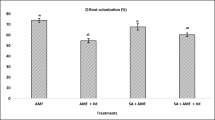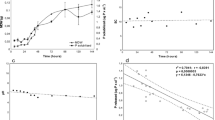Abstract
A study was conducted with the vine rootstock Richter 110 (Vitis berlandieri Planch. x Vitis rupestris L.) in order to assess whether the colonisation by the arbuscular mycorrhizal fungus (AMF) Glomus intraradices (BEG 72) can delay the disease development in plants inoculated with the root-rot fungus Armillaria mellea (Vahl:Fr) Kummer, and to elucidate if the levels of polyamines (PAs) are modified in response to G. intraradices, A. mellea or by the dual infection. Four treatments were considered: control and G. intraradices-inoculated plants infected or not with A. mellea. Plant growth, mycorrhizal colonisation and disease development were monitored throughout the experiment. High performance liquid chromatography (HPLC) in combination with fluorescence spectrophotometry was used to separate and quantify free root and leaf polyamines. The slower development of pathogenic symptoms and the higher plant biomass of mycorrhizal plants inoculated with A. mellea indicate an increase of tolerance due to the AMF inoculation. The variations in free PA levels detected at the beginning of the pathogenic infection suggest that PAs may have a potential role in the signalling mechanisms of the tolerance of mycorrhizal plants against A. mellea.


Similar content being viewed by others
References
Agrios GN (2005) How plants defend themselves against pathogens. In: Agrios, GN (eds) Plant pathology. 5th edn. Academic, San Diego, pp 98–117
Aguín O (2001) Detección, identificación y control de Armillaria mellea (Vahl: Fr.) Kummer en vid. PhD Thesis. Universidad de Santiago de Compostela, Departamento de Producción Vegetal.
Aguín O, Mansilla JP, Vilariño A, Sainz MJ (2004) Effects of mycorrhizal inoculation on root morphology and nursery production of three grapevine rootstocks. Am J Enol Vitic 55:108–111
Aguín-Casal O, Montenegro D, Mansilla JP (2006) Protección de la vid frente a Armillaria mellea mediante la aplicación de hongos micorrícicos. Nutri-Fitos 163:27–33
Alcázar R, Altabella T, Tiburcio AF (2003) Las poliaminas. In: Reigosa MJ, Pedrol N, Sanchez-Moreiras A (eds) La Ecofisiología vegetal. Una ciencia de síntesis. Paraninfo S.A. pp 725–747
Angellini R, Bragaloni M, Federico R, Infantion A, Porta-Puglia A (1993) Involvement of polyamines, diamine oxidase and peroxidase in resistance of chickpea to Ascochyta rabiei. J Plant Physiol 142:704–709
Azcón-Aguilar C, Jaizme-Vega MC, Calvet C (2002) The contribution of arbuscular mycorrhizal fungi to the control of soil-borne plant pathogens. In: Gianinazzi, S, Schüepp, H, Barea, JM, Haselwandter, K (eds) Mycorrhizal technology in agriculture. Birkhäuser Verlag, Switzerland, pp 187–197
Baumgartner K (2004) Root collar excavation for postinfection control of Armillaria root disease of grapevine. Plant Dis 88:1235–1240 doi:10.1094/PDIS.2004.88.11.1235
Baumgartner K, Rizzo DM (2006) Relative resistance of grapevine rootstocks to Armillaria root disease. Am J Enol Vitic 57:408–414
Baumgartner K, Warnock AE (2006) A soil inoculant inhibits Armillaria mellea in vitro and improves productivity of grapevines with root disease. Plant Dis 90:439–444 doi:10.1094/PD-90-0439
Baumgartner K, Smith RF, Bettiga L (2005) Weed control and cover crop management affect mycorrhizal colonisation of grapevine roots and arbuscular mycorrhizal fungal spore populations in a California vineyard. Mycorrhiza 15:111–119 doi:10.1007/s00572-004-0309-2
Bavaresco L, Fogher C (1996) Lime induced chlorosis of grapevine as affected by rootstock and root infection with arbuscular mycorrhiza and Pseudomonas fluorescens. Vitis 35:119–123
Beckman TG, Pusey PL (2001) Field testing peach rootstocks for resistance to Armillaria root rot. HortScience 36:101–103
Belles JM, Perez-Amador MA, Carbonell J, Conejero V (1991) Polyamines in plant infected by citrus exocortis viroid or treated with silver ions and ethephon. Plant Physiol 96:1053–1059
Bouchereau A, Aziz A, Larher F, Martin-Tanguy J (1999) Polyamines and environmental challenges: recent development. Plant Sci 140:103–125 doi:10.1016/S0168-9452(98)00218-0
Calvet C, Pinochet J, Camprubí A, Fernández C (1995) Increased tolerance to the root-lesion nematode Pratylenchus vulnus in mycorrhizal micropropagated BA-29 quince rootstock. Mycorrhiza 5:253–258
Camprubí A, Estaún V, Nogales A, García-Figueres F, Pitet M, Calvet C (2008) Response of the grapevine rootstock Richter 110 to inoculation with native and selected arbuscular mycorrhizal fungi and growth performance in a replant vineyard. Mycorrhiza 18:211–216 doi:10.1007/s00572-008-0168-3
Cheng X, Baumgartner K (2006) Effects of mycorrhizal roots and extraradical hyphae on 15N uptake from vineyard cover crop litter and the soil microbial community. Soil Biol Biochem 38:2665–2675 doi:10.1016/j.soilbio.2006.03.023
Darrieumerlou A, Geny L, Broquedis M, Donèche B (2001) Évolution de la composition en polyamines des baies de raisin au cours du processus d’infection par Botrytis cinerea. Vitis 40:11–15
Edreva A (1997) Tobacco polyamines as affected by stresses induced by different pathogens. Biol Plant 40:317–320 doi:10.1023/A:1001093209229
El Ghachtouli N, Paynot M, Morandi D, Martin-Tanguy J, Gianinazzi S (1995) The effect of polyamines on endomycorrhizal infection of wildtype Pisum sativum, cv. Frisson (nod+myc+) and two mutants (nod−myc +and nod−myc−). Mycorrhiza 5:189–192
El Ghachtouli N, Martin-Tanguy J, Paynot M, Gianinazzi S (1996) First report of the inhibition of Pisum sativum by specific and irreversible inhibition of polyamine biosynthesis or by gibberellic acid treatment. FEBS Lett 385:189–192 doi:10.1016/0014-5793(96)00379-1
Flores HE, Galston AW (1982) Analysis of polyamines in higher plants by high performance liquid chromatography. Plant Physiol 69:701–706
Foster SA, Walters DR (1990) The effects of polyamine biosynthesis inhibitors on mycelial growth, enzyme activity and polyamine levels in the oat-infecting fungus Pyrenophora avenae. J Gen Microbiol 136:233–239
Fox RTV (2003) Managing Armillaria root rot. Food Agric Environ 95:95–100
Fusconi A, Gnavi E, Trotta A, Berta G (1999) Apical meristems of tomato roots and their modifications induced by arbuscular mycorrhizal and soilborne pathogenic fungi. New Phytol 142:505–516 doi:10.1046/j.1469-8137.1999.00410.x
Galston AW, Kaur-Sawhney RK (1990) Polyamines in plant physiology. Plant Physiol 94:406–410
Geny L, Broquedis M, Martin-Tanguy J, Bouard J (1997) Free, conjugated and wall-bound polyamines in various organs of fruiting cuttings of Vitis vinifera cv. Cabernet-Sauvignon. Am J Enol Vitic 48:80–84
Giovannetti M, Mosse B (1980) An evaluation of techniques for measuring vesicular arbuscular mycorrhizal infection in roots. New Phytol 84:489–500 doi:10.1111/j.1469-8137.1980.tb04556.x
Goicoechea N, Szalai G, Antolín MC, Sánchez-Díaz M, Paldi E (1998) Influence of arbuscular mycorrhizae and Rhizobium on free polyamines and proline levels of water-stressed alfalfa. J Plant Physiol 153:706–711
Guo X, Li G, Shang Z, Li X, Liu Y (1999) Relationship between free polyamines and resistance of tobacco to TMV. Hebei Nongye Daxue Xuebao 22:32–35
Karagiannidis N, Nikolaou N, Matheou A (1995) Influence of three VA-mycorrhiza species on the growth and nutrient uptake of three grapevine rootstocks and one table grape cultivar. Vitis 34:85–89
Karagiannidis N, Nikolaou N, Ipsilantis I, Zioziou E (2007) Effects of different N fertilizers on the activity of Glomus mosseae and on grapevine nutrition and berry composition. Mycorrhiza 18:43–50 doi:10.1007/s00572-007-0153-2
Kaur-Sawhney R, Tiburcio AF, Altabella T, Galston A (2003) Polyamines in plants: an overview. J Cell Mol Biol 2:1–12
Khaosaad T, García-Garrido JM, Steinkellner S, Vierheilig H (2007) Take-all disease is systemically reduced in roots of mycorrhizal barley plants. Soil Biol Biochem 39:727–734 doi:10.1016/j.soilbio.2006.09.014
Koske RE, Gemma JH (1989) A modified procedure for staining roots to detect VA mycorrhizas. Mycol Res 92:486–505
Koussa T, Broquedis M, Dubos B (1997) Relation possible entre l’agressivité de deux souches d’Eutypa lata et leur contenu en polyamines et en acide abscissique. J Int Sci Vigne Vin 31:153–156
Li HY, Yang GD, Shu HR, Yang YT, Ye BX, Nishida I et al (2006) Colonisation by the arbuscular mycorrhizal fungus Glomus versiforme induces a defence response against the root-knot nematode Meloidogyne incognita in the grapevine (Vitis amurensis Rupr.), which includes transcriptional activation of the class III chitinase gene VCH3. Plant Cell Physiol 47:154–163 doi:10.1093/pcp/pci231
Liu J, Maldonado-Mendoza I, López-Meyer M, Cheung F, Town CD, Harrison MJ (2007) Arbuscular mycorrhizal symbiosis is accompanied by local and systemic alterations in gene expression and an increase in disease resistance in the shoots. Plant J 50:529–544 doi:10.1111/j.1365-313X.2007.03069.x
Ludwig-Müller J (2000) Hormonal balance in plants during colonisation by mycorrhizal fungi. In: Kapulnik, K, Douds, DD (eds) Arbuscular mycorrhizas: physiology and function. Kluwer Academic, Netherlands, pp 263–285
Martin-Tanguy J (1987) Hydroxycinnamic acid amides, hypersensitivity, flowering and sexual organogenesis in plants. In: Wettstein, D, Chua, DN (eds) Plant molecular biology. Plenum, New York, pp 253–263
Menge JA, Raski DJ, Lider LA, Johnson ELV, Jones NO, Kissler JJ (1983) Interactions between mycorrhizal fungi, soil fumigation, and growth of grapes in California. Am J Enol Vitic 34:117–121
Minocha R, Shortle WC, Lawrence GB, David MB, Minocha SC (1997) Relationships among foliar chemistry, foliar polyamines, and soil chemistry in red spruce trees growing across the northeastern United States. Plant Soil 191:109–122 doi:10.1023/A:1004293523185
Ndayiragije A, Lutts S (2007) Long term exogenous putrescine application improves grain yield of a salt-sensitive rice cultivar exposed to NaCl. Plant Soil 291:225–238 doi:10.1007/s11104-006-9188-y
Nikolaou N, Angelopoulos K, Karagiannidis N (2003) Effects of drought stress on mycorrhizal and non-mycorrhizal Cabernet Sauvignon grapevine, grafted onto various rootstocks. Exp Agric 39:241–252 doi:10.1017/S001447970300125X
Norman JR, Atkinson D, Hooker JE (1996) Arbuscular mycorrhizal fungal-induced alteration to root architecture in strawberry and induced resistance to the root pathogen Phytophthora fragariae. Plant Soil 185:191–198 doi:10.1007/BF02257524
Paradi I, Bratek Z, Láng F (2003) Influence of arbuscular mycorrhiza and phosphorus supply on polyamine content, growth and photosynthesis of Plantago lanceolata. Biol Plant 46:563–569 doi:10.1023/A:1024819729317
Paschaladis KA, Aziz A, Geny L, Primikirios NI, Roubelakis-Angelakis KA (2001) Polyamines in grapevine. In: Roubelakis-Angelakis, KA (eds) Molecular biology & biotechnology of the grapevine. Kluwer Academic, Netherlands, pp 109–151
Pozo MJ, Cordier C, Dumas E, Gianinazzi S, Barea JM, Azcón-Aguilar C (2002) Localized vs systemic effect of arbuscular mycorrhizal fungi on defence responses to Phytophthora infection on tomato plants. J Exp Bot 53:525–534 doi:10.1093/jexbot/53.368.525
Raabe R (1988) Armillaria root rot. In: Pearson, RC, Goheen, AC (eds) Compendium of grape diseases. American Phytopathological Society, St. Paul, MN, pp 35–36
Rajam B, Rajam MV (1996) Inhibition of polyamine biosynthesis in plant pathogenic fungi in vitro. Mycopathologia 133:95–103 doi:10.1007/BF00439120
Rifai LA, Koussa T, Geny L, Fassouane A, Dubos B, Broquedis M (2004) Évolution des teneurs en polyamines dans les fleurs et les jeunes baies de Vitis vinifera L. (cv. Cabernet Sauvignon) atteints d’eutypiose. Vitis 43:139–144
Rifai LA, Koussa T, Geny L, Fassouane A, Broquedis M, Dubos B (2005) Évolution des teneurs en polyamines libres et conjuguées dans les feuilles de vigne (Vitis vinifera ”Cavernet Sauvignon“) saine et atteinte d’eutypiose. Can J Bot 83:194–201 doi:10.1139/b04-165
Rishbeth J (1976) Chemical treatment and inoculation of hardwood stumps for control of Armillaria mellea. Ann Appl Biol 82:57–70 doi:10.1111/j.1744-7348.1976.tb01672.x
Sannazzaro AI, Echeverria M, Alberto EO, Ruiz OA, Menendez AB (2007) Modulation of polyamine balance in Lotus glaber by salinity and arbuscular mycorrhiza. Plant Physiol Biochem 45:39–46 doi:10.1016/j.plaphy.2006.12.008
Torrigiani P, Serafini-Fracassini D, Fara A (1989) Diamine oxidase activity in different physiological stages of Helianthus tuberosus tuber. Plant Physiol 89:69–73
Walters DR (2000) Polyamines in plant–microbe interactions. Physiol Mol Plant Pathol 57:137–146 doi:10.1006/pmpp.2000.0286
Waschkies C, Schropp A, Marschner H (1994) Relations between grapevine replant disease and root colonisation of grapevine (Vitis sp.) by fluorescent pseudomonads and endomycorrhizal fungi. Plant Soil 162:219–227 doi:10.1007/BF01347709
Whipps JM, Haselwandter K, MCGee EEM, Lewis DH (1982) Use of biochemical markers to determine growth, development and biomass of fungi in infected tissues, with particular reference to antagonistic and mutualistic biotrophs. Trans Br Mycol Soc 79:785–400
Wróbel-Kwiatkowska M, Lorenc-Kukula K, Starzycki M, Oszmianski J, Kepczynska E, Szopa J (2004) Expression of β-1,3-glucanase in flax causes increased resistance to fungi. Physiol Mol Plant Pathol 65:245–256 doi:10.1016/j.pmpp.2005.02.008
Acknowledgements
Financial support for this research was provided by the Instituto de Investigación y Tecnología Agraria y Alimentaria (INIA), project RTA-04-027-C2-1, by the “Departament d’Universitats, Recerca i Societat de la Informació de la Generalitat de Catalunya” and by the European Regional Development Fund.
Author information
Authors and Affiliations
Corresponding author
Additional information
Responsible Editor: Harsh P. Bais.
Rights and permissions
About this article
Cite this article
Nogales, A., Aguirreolea, J., Santa María, E. et al. Response of mycorrhizal grapevine to Armillaria mellea inoculation: disease development and polyamines. Plant Soil 317, 177–187 (2009). https://doi.org/10.1007/s11104-008-9799-6
Received:
Accepted:
Published:
Issue Date:
DOI: https://doi.org/10.1007/s11104-008-9799-6




